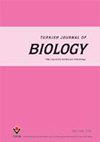地方性半毛茛对MCF-7乳腺癌细胞系的细胞毒性和凋亡作用
IF 0.9
4区 生物学
Q3 BIOLOGY
引用次数: 11
摘要
本研究的主要目的是分析半人马提取物的细胞毒性活性,以及从该提取物中洗脱的部分,在乳腺癌细胞中的作用。经分离和结构分析,表明其具有明显的细胞毒作用。分析的目的是通过研究这些部分的凋亡方面和确定作为基因产物的几种蛋白质的数量来揭示这种作用发生的机制。将试验物质作用于乳腺癌细胞,采用MTT和ATP测定引起细胞毒性作用的抑制浓度50 (IC50)。半人马二氯甲烷提取物-乙酸乙酯组分(CFDCMEAF)对MCF-7细胞有较强的生长抑制作用(45.771 μg/mL)。采用双染色和流式细胞术观察其对细胞凋亡的影响。CFDCM-EAF IC50剂量处理的细胞死亡率约为90%,其中活细胞9.2%,坏死细胞22.8%,晚期凋亡细胞62.3%,早期凋亡细胞5.8%。采用色谱法对CFDCM-EAF进行结构分析,结果表明CFDCM-EAF具有明显的细胞毒作用。LC-APCI-MS/MS分析结果表明,CFDCM-EAF的主要成分为Hispidulin。本文章由计算机程序翻译,如有差异,请以英文原文为准。
Cytotoxic and apoptotic effects of endemic Centaurea fenzlii Reichardt on the MCF-7 breast cancer cell line
The main purpose of this study was to analyze the cytotoxic activity of an extract obtained from Centaurea fenzlii Reichardt, and the fractions eluted from this extract, in breast cancer cells. After isolation and structural analysis of the fractions were conducted, a meaningful cytotoxic effect was indicated. The goal of the analysis was to reveal the mechanism by which this effect occurs through researching the apoptotic side of these fractions and determining the amount of several proteins that are the products of the genes. Test substances were applied to breast cancer cells and the inhibitory concentration value 50 (IC50) that caused a cytotoxic effect was determined using MTT and ATP assays. The Centaurea fenzlii Reichardt dichloromethane extracts-ethyl acetate fractions (CFDCMEAF) exhibited a stronger growth-inhibitory effect on MCF-7 cells (45.771 μg/mL). The apoptotic effect was studied using double staining and flow cytometry. The death rate in the cells treated with the CFDCM-EAF IC50 dose was approximately 90%: 9.2% living cells, 22.8% necrotic cells, 62.3% late apoptotic cells, and 5.8% early apoptotic cells. Structural analysis of the CFDCM-EAF, which indicated significant cytotoxic effects, was performed using chromatographic methods. Hispidulin was the major component of the CFDCM-EAF by LC-APCI-MS/MS analysis.
求助全文
通过发布文献求助,成功后即可免费获取论文全文。
去求助
来源期刊

Turkish Journal of Biology
BIOLOGY-
CiteScore
4.60
自引率
0.00%
发文量
20
审稿时长
6-12 weeks
期刊介绍:
The Turkish Journal of Biology is published electronically 6 times a year by the Scientific and Technological
Research Council of Turkey (TÜBİTAK) and accepts English-language manuscripts concerning all kinds of biological
processes including biochemistry and biosynthesis, physiology and metabolism, molecular genetics, molecular biology,
genomics, proteomics, molecular farming, biotechnology/genetic transformation, nanobiotechnology, bioinformatics
and systems biology, cell and developmental biology, stem cell biology, and reproductive biology. Contribution is open
to researchers of all nationalities.
 求助内容:
求助内容: 应助结果提醒方式:
应助结果提醒方式:


